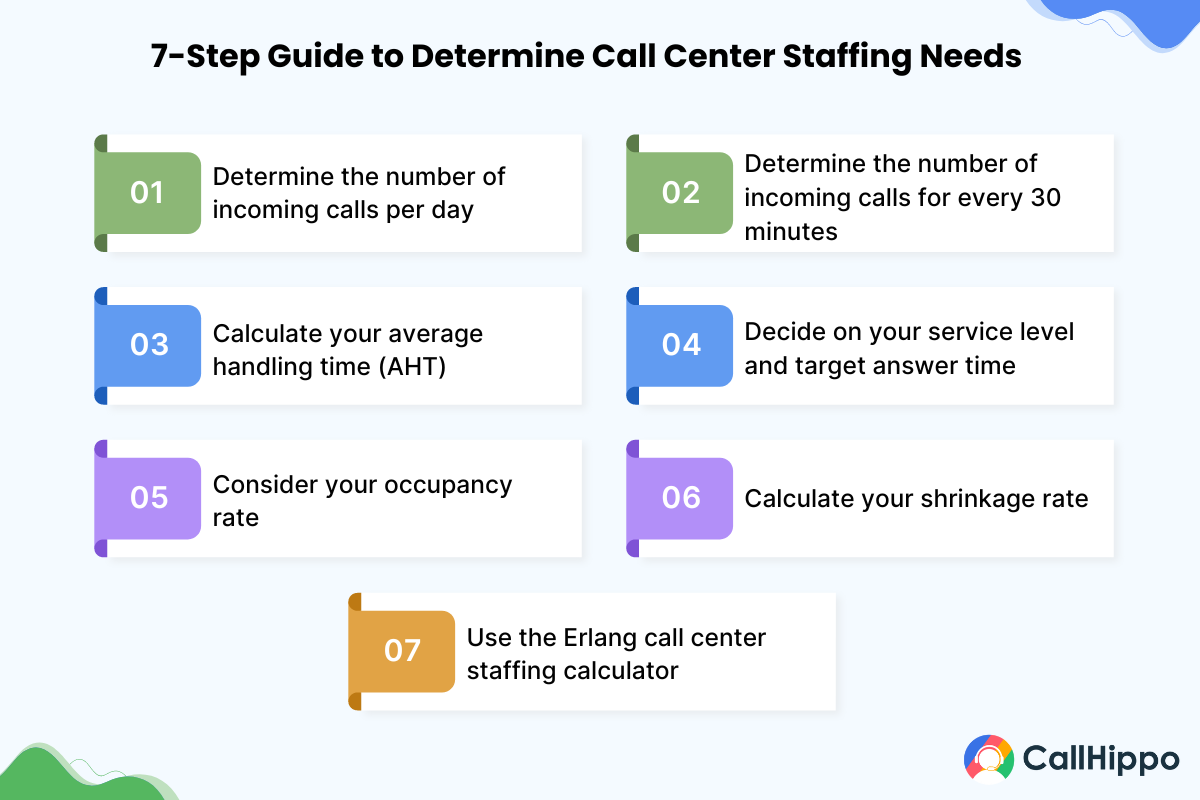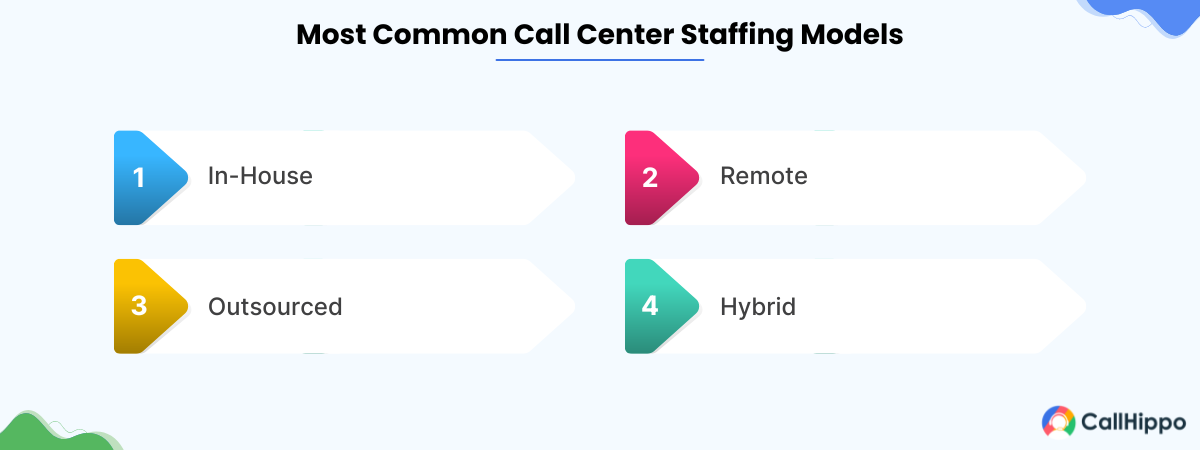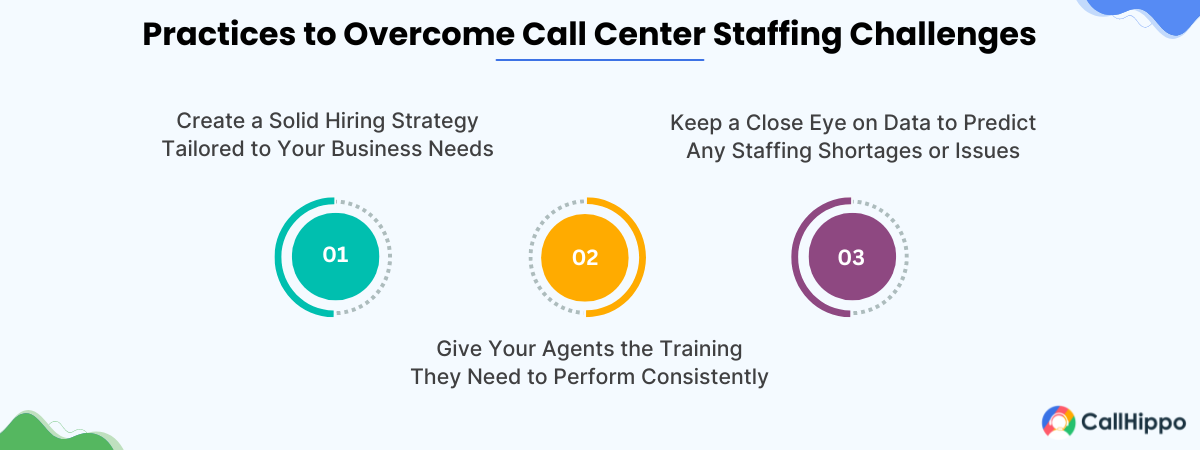Running a call center successfully is all about getting the numbers right. However, it could be difficult for new and growing call centers to determine how many agents they exactly need to handle all the incoming calls while still making a profit. Many challenges are faced by call centers around the globe and staffing is one of them.
If it sounds familiar, we have got a solution for you. In this article, we will explain how to calculate call center staffing exactly so you can run your operations efficiently.
7 Steps To Calculate the Number of Agents Required in a Call Center
Learn how to calculate the number of agents needed for your call center in 7 simple steps. This guide will help you optimize staffing for efficiency and customer satisfaction.

Step 1: Determine the number of incoming calls per day
The first step to calculate the number of agents you need in your call center is determining the number of incoming calls per day. There are several ways to do so, depending on the information you have access to, such as:
- Automated call distributed (ACD) system: If you are in an established call center, your ACD system will give you accurate calls-per-day data.
- Call detail records (CDRs): If you don’t have access to the ACD system, you can find calls-per-day data in your call logging system or switchboard in the CDR.
- Telephone company: If you don’t have access to the above options, consider contacting your telephone company to access the number of incoming calls per day.
- Ask your agents: Ask your agents to log the number of calls they receive manually. Add all the numbers to determine the total number of incoming calls. However, this number will differ every day, so you will have to take an average of at least a month.
- CRM: If you track customer engagement in your CRM system, it will also reflect the number of incoming calls.
If you cannot determine the number of incoming calls by any of the options mentioned above, you can estimate it by the following method:
Suppose:
- You have 100,000 customers
- Each customer calls three times a year
- You’re open 250 days a year
Then, your incoming calls per day will be:
- 100,000 X 3 = 300,000
- 300,000/250 = 1200 calls per day
CallHippo addressed Finofy Technologies' communication challenges by providing reliable call connectivity, improved call quality, and a user-friendly interface.

Step 2: Determine the number of incoming calls for every 30 minutes/hour
The next step is to determine the number of incoming calls for each 30-minute period of the day.
One way to determine it is by looking at your ACD system. Or, you can calculate it from the number you discovered in step 1. For example, if your call center is open from 9 AM to 5 PM, that’s 8 hours, minus a one-hour break.
Your number of incoming calls for every 30 minutes/hour will be:
- 1200/7= 171.4
- 171.4/2= 85.7 = 86 (approx.)
Step 3: Calculate your average handling time (AHT)
Average handling time refers to the amount of time your agents spend handling a call.
Typically, AHT = Call duration + After-call Work time
You can find this information from your ACD or CRM and then calculate the AHT.
The average call handling time across industries is 4.9 minutes (294 seconds). However, it could increase depending on the complexity of your business.

Step 4: Decide on your service level and target answer time
Service level refers to the percentage of incoming calls that agents answer during a set amount of time. Most modern call centers aim to answer 90% of calls within 10-15 seconds as it will improve the first call resolution rate.
Remember, the lower your target answer time, and the higher your service level, the more satisfied your customers will be (as they won’t have to wait longer).

Also, the higher the service level, the more the number of staff required. Therefore, it is up to you to decide on the percentage of service level and target answer time that keeps you competitive and does not require hiring too many agents.
Step 5: Consider your occupancy rate
The occupancy rate refers to the percentage of time agents use doing call-related work against the available time. An ideal occupancy rate is between 85-90%.
Your occupancy rate plays a significant role in determining the number of agents required. Just like service level, set your occupancy rate (if you haven’t yet).
Step 6: Calculate your shrinkage rate
Shrinkage rate in call center refers to the amount of time an agent is not available to do productive work, such as answering calls, responding to support tickets, etc., despite being paid for it.
This includes both internal (when the agent is in the call center but cannot attend calls due to team meetings, breaks, etc.) and external call shrinkage (when the agent is out of the call center due to sickness, paid leaves, emergencies, etc.).
The industry standard for shrinkage is 35%, but you can work to reduce it.
Step 7: Use the Erlang call center staffing calculator
Lastly, enter all the numbers you calculated from steps 1 to 6 in the Erlang call center staffing calculator.
It enables you to determine how many call center agents you need during each 30-minute (customizable to 15 minutes, 1 hour, and so on) the day.
For example, the number of advisors needed for the below numbers would be:
- Number of incoming calls per day = 1200
- Number of incoming calls for every 30 minutes/hour = 86
- Average handling time = 220 seconds
- Service level = 90%
- Target answer time = 20 seconds
- Occupancy rate = 85%
- Shrinkage rate = 30%
The number of agents required every 30 minutes is 21.5 agents.
The 4 Most Common Call Center Staffing Models
When it comes to staffing a call center, choosing the right model is crucial for operational efficiency and customer satisfaction. Here are the four most common call center staffing models:

1. In-House
An in-house call center staffing model involves maintaining your customer support team within your organization, directly under your management.
This model provides better control over operations, enhanced team collaboration, and consistent quality standards. However, it can also be more expensive due to office space, equipment, and staffing costs.
Pros
- Full control over operations and agent performance.
- Direct communication with agents, allowing for immediate feedback and adjustments.
- Strong data privacy and security since all operations are managed internally.
Cons
- Requires significant investment in hiring, training, and technology.
- Scaling can be challenging, especially during peak times or rapid growth periods.
2. Remote
Remote call centers leverage the flexibility of agents working from home or other remote locations. This model can reduce overhead costs and increase access to a broader talent pool.
It also provides flexibility in scheduling, which can help manage fluctuations in call volume. Remote work can improve work-life balance, leading to higher job satisfaction and retention rates.
Pros
- It attracts a wider talent pool as geographic limitations are removed.
- Cost savings on office space and utilities.
- Flexibility in scheduling allows for better coverage across different time zones.
Cons
- Requires robust technology and security measures to protect sensitive data.
- Managing a remote team can be more challenging due to communication barriers and potential isolation.
3. Outsourced
Outsourcing involves hiring a third-party company to handle your call center needs. This can be a cost-effective solution, especially for businesses looking to scale quickly or handle large call volumes.
Top outsourcing companies also provide access to specialized expertise and can allow your internal team to focus on core business operations.
Pros
- Reduces the burden of recruitment, training, and management.
- Often more cost-effective, especially for businesses without the resources to maintain an in-house team.
- Access to specialized expertise and technology that may not be available internally.
Cons
- Less control over the quality of service and agent performance.
- Potential challenges in communication and alignment with company culture.
4. Hybrid
A hybrid model combines elements of in-house, remote, and outsourced call centers. This approach allows for flexibility, enabling you to balance the advantages of in-house control with the cost savings of outsourcing or remote work.
Hybrid models are often tailored to a company’s specific needs and can be adjusted based on seasonal demand or other factors.
Pros
- Combines the benefits of in-house and outsourced agents for maximum flexibility and control.
- Allows the company to scale up or down quickly to meet fluctuating call volumes.
- Provides access to specialized expertise and language skills from outsourced agents when needed.
Cons
- Requires coordination and communication between in-house and outsourced teams.
- It may be more complex to manage than a single staffing model.
3 Best Practices to Overcome Call Center Staffing Challenges
Call center staffing challenges can significantly impact customer satisfaction and operational efficiency. Here are three best practices to overcome these challenges:

1. Create a Solid Hiring Strategy Tailored to Your Business Needs
Align your hiring process with your business objectives by clearly defining the skills and experience required for your agents. Focus on recruiting individuals who can thrive in your specific call center environment, whether it’s fast-paced sales or customer support.
A well-defined hiring strategy helps in reducing turnover and ensuring a high level of performance from the start.
2. Give Your Agents the Training They Need to Perform Consistently
Providing comprehensive training equips your agents with the knowledge and tools they need to handle various customer scenarios. Invest in ongoing training programs that focus on skill development, product knowledge, and customer service best practices.
Well-trained agents are more confident, effective, and less likely to make errors, reducing the need for excessive supervision and improving overall customer satisfaction.
3. Keep a Close Eye on Data to Predict Any Staffing Shortages or Issues
Use data analytics to monitor call center performance, including call volume trends, average handling time, and agent availability. This data can help you identify potential staffing shortages before they occur and make necessary adjustments.
Regularly reviewing this information allows for proactive decision-making, ensuring your call center is always adequately staffed to meet customer demand.
Conclusion
Calculating call center staffing accurately helps you manage most of the incoming calls daily while still making a profit. Use the steps mentioned above to determine the number of staff you need in your contact center.

Subscribe to our newsletter & never miss our latest news and promotions.









